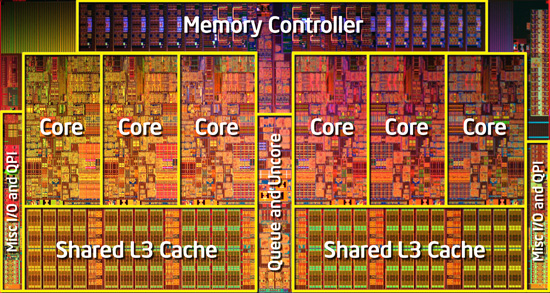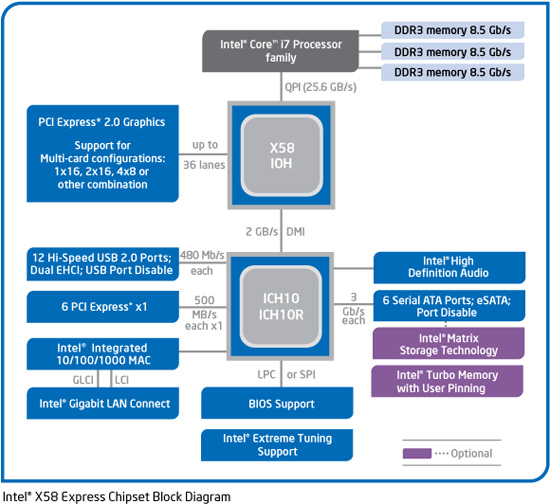The Core i7 980X Review: Intel's First 6-Core Desktop CPU
by Anand Lal Shimpi on March 11, 2010 12:00 AM EST- Posted in
- CPUs
A 12MB L3 Cache: 50% Larger, 14% Higher Latency
Gulftown sticks to Ronak’s 2MB of L3 per core rule and has a full, 12MB shared L3 cache that’s accessible by any or all of the six cores. It’s actually because of the large unified L3 cache that performance in applications that don’t use all six cores can be higher than quad-core Core i7s.

Nehalem

Gulftown
The added cache does come at the expense of higher access latency. Nehalem and Lynnfield had a 42-cycle 8MB L3, Gulftown has a 48 cycle 12MB L3. A 14% higher latency for a 50% increase in size. Not an insignificant penalty, but a tradeoff that makes sense.
Identical Power Consumption to the Core i7 975
Raja has been busy with his DC clamp meter measuring actual power consumption of CPUs themselves rather than measuring power consumption at the wall. The results below compare the actual power draw of the 32nm Core i7 980X to the 45nm Core i7 975. These values are just the CPU itself, the rest of the system is completely removed from the equation:
| CPU | Intel Core i7 980X | Intel Core i7 975 |
| Idle | 6.3W | 6.3W |
| Load | 136.8W | 133.2W |
Thanks to power gating, both of these chips idle at 6.3W. That's ridiculous for a 1.17B transistor chip. Under full load, the two are virtually identical - both drawing around 136W.
Westmere Goodness
The Core i7 980X is the first LGA-1366 processor based on Intel’s Westmere architecture, but unlike Clarkdale it does not have an on-die PCIe controller or on-package graphics. If anything, Gulftown really looks like a 6-core, 32nm version of Bloomfield rather than a scaled up Clarkdale. The similarities to Bloomfield extend all the way to the memory controller. Gulftown only officially supports three channels of DDR3-1066 memory, not 1333MHz like Lynnfield or Clarkdale. Of course running DDR3-1333 memory is possible, but the memory controller is technically operating out of spec at that frequency.

The processor does retain the Westmere specific features. The first Core i7 did not power gate its L3 cache, Lynnfield added it and Gulftown has it as well. While Mainly improved power efficiency and AES-NI instructions. I looked at the performance improvement offered by AES-NI acceleration in our Clarkdale review. If you use BitLocker or do a lot of archive encryption/decryption, you'll appreciate Gulftown's AES-NI.










102 Comments
View All Comments
LoneWolf15 - Thursday, March 11, 2010 - link
[QUOTE]With up to 6 cores running at 3.46GHz, Gulftown is not only the fastest CPU in Intel’s lineup, it’s also the fastest quad-core Intel makes.[/QUOTE]I think you meant to say it's also the fastest "single-core" Intel makes.
yacoub - Thursday, March 11, 2010 - link
And for only one thouuuuusand dollars! What a deal!!
lol yeah, anyone who spent $999 on an X58 CPU can now spend $999 on a new cpu 18 months later. $2000 for two CPUs in the course of 18 months. How you can spin that as being a good thing boggles the mind. What a waste!
strikeback03 - Thursday, March 11, 2010 - link
Well, maybe you spent the ~$280 or so on a 920 in November 08, which you could now upgrade to the 980X if you wanted. Considering Intel's past history of supporting new processors on older motherboards (see, for example, P965 and Penryn) it is nice that this is supported, even if the upgrade is extremely expensive.BelardA - Thursday, March 11, 2010 - link
Kinda sad and funny... when core 2 came out, it destroyed the P4 line and of course kicked AMD down bad.Even todays $65 intels and $45 AMDs (running about 2ghz) are still faster than those older Pentium EE chips. And what was sadder back then was that even AMD's $200 CPUs were still faster than the $1000 intels... unless your were doing 3D work and encoding video.
*sigh*
Thanks to intel's back-room deals with the major PC companies, the illegal activities has hurt competition. AMD is doing better today, but have little to work with. And we see what the lack of competition does such as ATI vs. Nvidia.
andyleung - Thursday, March 11, 2010 - link
Why they keep the CPU frequency so high? All consumer quad cores go higher than 2.5GHz??? I really like Opterons, low frequency with more cores.Seriously I hope Phenom VI (I made it up, they may call it something else) could have a model of 6 cores with each running 1.2GHz.
My own usage is mostly programming in JEE + documentation, so I need more cores but not that fast, so I could save a few bucks on my electricity bill in a year. :)
yuchai - Thursday, March 11, 2010 - link
You can always underclock/undervolt if you don't need the performance from the extra speed but want the power savings.Note that this is the "Extreme" version, so it makes sense to have the fastest speeds possible. The mainstream versions that are coming will probably have lower clock speeds.
at80eighty - Thursday, March 11, 2010 - link
Maybe I missed it - but would this have any predicted implications on the 920 price over this year span?I'm rebuilding a rig a component at a time and Im wondering if there would be much variance if I picked a 920 now or in Q4
/tard
IntelUser2000 - Thursday, March 11, 2010 - link
"The first Core i7 did not power gate its L3 cache, Lynnfield added it and Gulftown has it as well."THANK YOU ANAND!!
No wonder this is my #1 favored site. :D
darkhawkff - Thursday, March 11, 2010 - link
I don't know about anyone else, but I would have liked to have seen how this chip fares to overclocks of Intel's other Core i7 series. While I'm sure many people don't bother overclocking, I would wager that most people who visit this site do, and probably bought into the Core i7 920 series and overclocked it to 4 GHz or more. While I'm sure the Core i7 980X is a beast, I'd be more interested in seeing how it fares when overclocked parts are taken into account, because personally I see very little reason to make the jump from the 920 to the 980 after this review. 2 more cores are nice, but not when they are slower.B3an - Thursday, March 11, 2010 - link
Anand, can you please include newer software for some benches. For instance you are still using 3DS Max 9 which was released in 2006.The latest is 3DS MaX 2010 (version 12).
I only ask because i'm sure that anyone who can afford this CPU can ceratinly afford the latest 3D rendering/modelling software. And besides that they might have better support/performance for these type of CPU's.